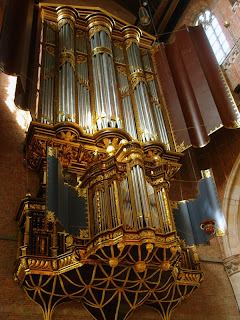Writing about music is not easy. How to express what one feels or experiences when listening to music, or seeing someone perform, someone who is totally transformed and lost in the music, trying to get into the mind of the composer, relive that experience, that creative process, as if hearing and discovering the music for the first time.
This past weekend has been a weekend full of music, and some of it very memorable.
On Friday afternoon, the son of friends, their only child and extremely talented, played a piano recital for his MA examination in the Royal School of Music in The Hague. I had heard him play before, during lunchtime recitals, alone and with friends playing other instruments. As an accompanist he was extremely good, supporting the soloists, and not taking first place. Also he seemed confident and to enjoy what he was doing. This time, his program was very ambitious and comprised four different genres.
J.P. Sweelinck Fantasia Crommatica
C. Franck Prelude, Choral et Fugue
A. Skriabin Sonata Nr. 9 "Messe Noir"
F. Schubert Wanderfantasie
The Sweelinck is originally written for organ or harpsichord, not for piano. I had expected it to be dull. Sweelinck is very mathematical, and how does one translate that for piano. An organ has stops, so one can make the music more interesting by making use of them. But it wasn't dull at all, fascinating and played very sensitively, with a light but varied touch.
It is amazing to see such a young musician disappearing into a different world, the world of the composer, internalising the music, making it his own and recreating it, being the music. It seems astonishing that complicated music like this, a programme which filled an hour and fifteen minutes, can be played by heart, without any score. On the other hand, music can only be performed like that if it one knows it by heart, so that one can really build up phrases, be the music. Of course every soloist does that, but seeing it done by somebody so young and sitting so near, is fascinating.
Skriabin's music was really difficult, and totally different from Sweelinck. And Schubert was a surprise, the mood changing all the time, fingers touching the keys as if water was dancing over stones in a fast streaming brook.
He passed with flying colours. Afterwards we had drinks somewhere with some friends and his parents, and he was just his normal self again, modest, kind.
Skriabin
This is the piece by Sweelinck played on the organ. There are also versions on the internet where the Fantasia Crommatica is played on a harpsichord
That evening I went to the choir practice of our church choir.
The following day it was off to Rotterdam for a final practice with the ECS for our week in Ely cathedral this August. We worked hard from 10.30-16.00 hrs. It is obvious that I will have to study quite a few things at home! But it was a joyful and fruitful practice. I was back just in time for a festive gathering in our street, the annual street BBQ which this time was held in the home of one of my neighbours, because of the inclement weather which we hadn't bargained for. Many former residents of this street came back specially for the occasion, even from Germany and Norway! We are a remarkable street and have shared sorrow and happiness for many years. Although I tried not to drink too much and not to go home too late, it was still very difficult to get up the next morning, in time for the service in The Hague. But I did not want to miss it, as the anthem was Tchaikovsky's hymn to the Trinity, a beautiful anthem, very appropriate for Trinity Sunday.
Not the best rendering of the hymn, but I could not find anything else
Once we sang it during a Choral Festival, and the singers spread out among the worshippers, so that the sound came from everywhere. It was hauntingly beautiful. Our church choir is only small, so it was not something we could repeat. Nevertheless the music touches me every time I sing it.











